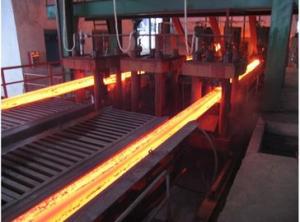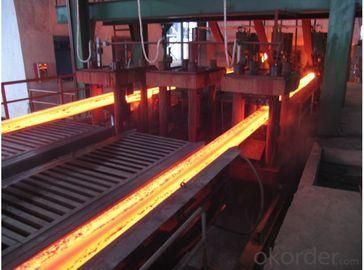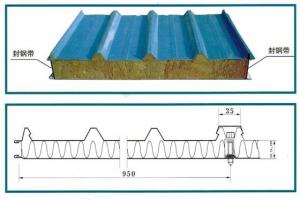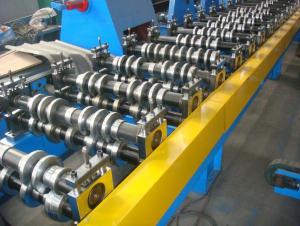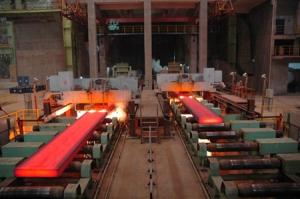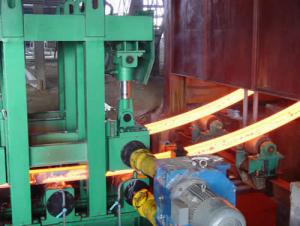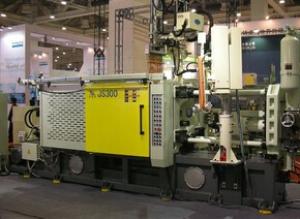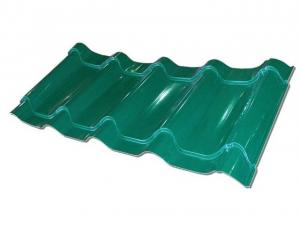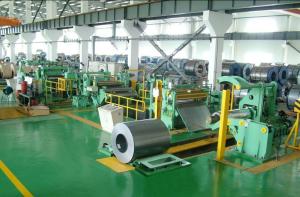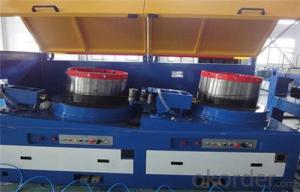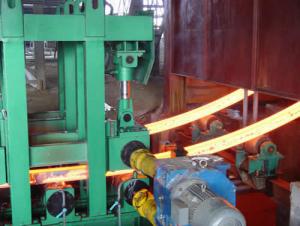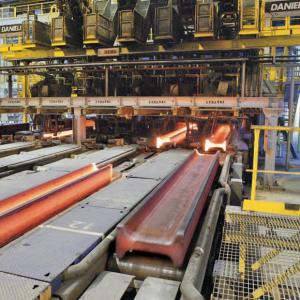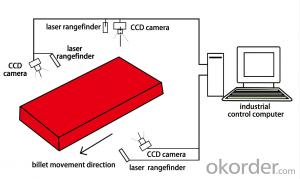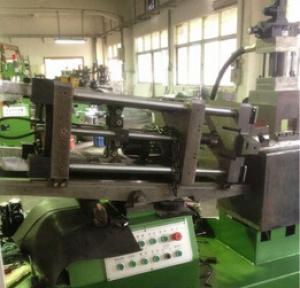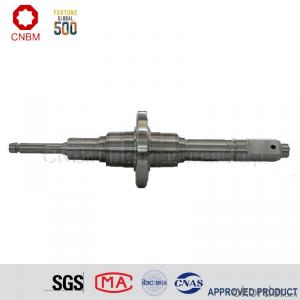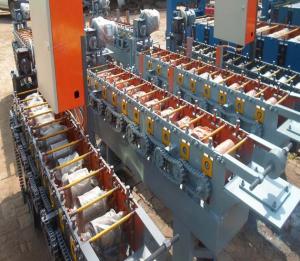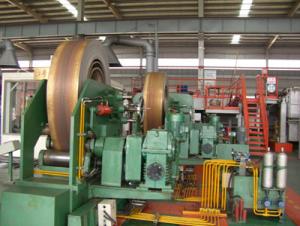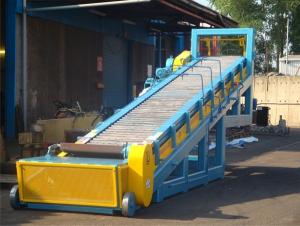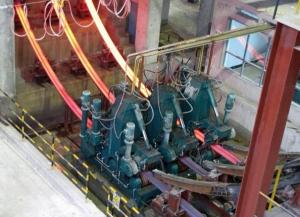Continuous Casting Machine for Square Billet
- Loading Port:
- China Main Port
- Payment Terms:
- TT or LC
- Min Order Qty:
- 1 Set set
- Supply Capability:
- 20 Sets Per Year set/month
OKorder Service Pledge
Quality Product, Order Online Tracking, Timely Delivery
OKorder Financial Service
Credit Rating, Credit Services, Credit Purchasing
You Might Also Like
Technology process:
1.Heat the EVA film
2.Cover the heated EVA film on the mould(can be made from wood or aluminum)
3.Spray a coating in a certain baume degree
4.Put on the empty blask
5.Sand-up the flask and vibrate to compaction
Packaging & Delivery
Packaging Details:containers
Delivery Detail:Complete one set of equipment needs for three months
- Q: What are the common cooling methods used in metal casting machinery?
- Proper cooling and solidification of molten metal in metal casting machinery is ensured through the utilization of various common cooling methods. These methods encompass: 1. Implementation of Water Cooling: Water stands out as a widely employed cooling agent in metal casting machinery. It is strategically circulated through channels or pipes within the casting mold or machinery itself to absorb heat from the molten metal. This method swiftly reduces the metal's temperature and encourages solidification. 2. Adoption of Air Cooling: Metal casting machinery also commonly utilizes air cooling. This method revolves around circulating air around the casting mold or machinery to extract heat from the metal. Air cooling often synergizes with other cooling techniques to enhance the cooling process. 3. Application of Forced Convection: Forced convection entails the utilization of fans or blowers to amplify airflow and expedite heat transfer. This technique proves particularly advantageous for larger metal castings or machinery that may not achieve sufficient cooling through natural convection alone. 4. Utilization of Heat Sink Cooling: Metal casting machinery incorporates heat sinks to absorb and dissipate heat. Typically composed of materials with high thermal conductivity, such as copper or aluminum, heat sinks establish direct contact with the hot metal to effectively draw away heat. 5. Employment of Indirect Cooling: Indirect cooling methods involve the utilization of cooling fluids, such as oils or refrigerants, which circulate through a closed loop system. These cooling fluids absorb heat from the metal and subsequently undergo external cooling using means such as heat exchangers or cooling towers. 6. Implementation of Spray Cooling: Spray cooling encompasses the directed application of a fine mist or spray of water or other cooling fluids onto the metal casting's surface to facilitate rapid cooling. This technique proves particularly effective when applied to thin-walled castings or intricate shapes. Collectively, these cooling methods hold paramount importance in metal casting machinery by ensuring proper solidification, defect prevention, and overall enhancement of casting quality. The choice of cooling method depends on factors such as casting size and complexity, the type of metal being cast, and the desired cooling rate.
- Q: How long does it take to set up metal casting machinery?
- The time it takes to set up metal casting machinery can vary due to several factors, including the size and complexity of the machinery, the operators' experience, and the casting process requirements. Generally, the setup process can take anywhere from a few hours to several days. Smaller machines or simpler casting processes can be set up relatively quickly. This involves tasks like assembling the machinery, connecting power and water supplies, and calibrating necessary settings. By carefully planning and organizing, this setup can be completed within a few hours. However, larger and more complex machinery requires a more extensive setup time. These machines often involve additional steps, such as aligning components, installing specialized tools or molds, and conducting thorough testing and calibration. Moreover, operators may need training to familiarize themselves with the machinery and casting process, which further adds to the setup time. Moreover, the specific requirements of the casting process itself can influence the setup time. Different casting methods, like sand casting, investment casting, or die casting, may require different setup procedures and equipment. The complexity of the desired product, including its size, intricacy, and material requirements, also impacts the setup time. Efficiency and experience are crucial in determining the setup time. Experienced operators familiar with the machinery and casting process can complete the setup more swiftly. Adequate planning, organization, and preparation of materials and resources also help streamline the setup process. In conclusion, setting up metal casting machinery typically ranges from a few hours to several days, depending on various factors.
- Q: Can metal casting machinery handle the production of long continuous castings?
- Yes, metal casting machinery can handle the production of long continuous castings.
- Q: What are the common finishing processes used for castings produced by metal casting machinery?
- Castings produced by metal casting machinery undergo several common finishing processes to ensure they meet desired specifications and are suitable for their intended applications. One of these processes is machining, which utilizes cutting tools to remove excess material and achieve the desired shape and dimensions of the casting. Depending on the complexity of the casting, machining can be carried out manually or using computer numerical control (CNC) machines. Grinding is another widely used finishing process that eliminates any surface irregularities or imperfections left after the casting process. Abrasive wheels or belts are employed in grinding to achieve a smooth and uniform surface finish. To enhance appearance and protect against corrosion, surface treatment processes are commonly employed. Sandblasting, involving high-speed particles to clean and roughen the surface, and shot blasting, using high-velocity steel shots to remove burrs and improve surface quality, are examples of surface treatment methods. Additionally, castings may undergo processes such as polishing, buffing, or lapping to acquire a high-quality surface finish. These procedures employ abrasive compounds or polishing wheels to eliminate any remaining imperfections and create a smooth and shiny surface. In some cases, heat treatment processes are necessary to enhance the mechanical properties of the castings. Heat treatment methods like annealing, tempering, or quenching are utilized to modify the hardness, strength, and ductility of the castings. In conclusion, the common finishing processes for castings produced by metal casting machinery include machining, grinding, surface treatment, polishing, heat treatment, and others. These processes are vital for achieving the desired shape, dimensions, surface finish, and mechanical properties of the castings.
- Q: Can metal casting machinery be used for the production of food industry equipment?
- Indeed, metal casting machinery has the capability to be employed in the manufacturing of equipment for the food industry. The process of metal casting involves the pouring of molten metal into a mold, resulting in the creation of a desired shape. This procedure enables the production of intricate and complex parts with exceptional precision and consistency. Within the food industry, a multitude of equipment and components are necessary for the processing, packaging, and manipulation of food products. These encompass mixing tanks, conveyor belts, cutting blades, heat exchangers, and numerous others. By utilizing metal casting machinery, it becomes possible to fabricate these equipment and components using food-grade materials like stainless steel or aluminum. Food-grade metals possess qualities such as corrosion resistance, ease of cleaning, and safety for direct contact with food. Metal casting facilitates the construction of customized designs and shapes tailored to the specific requirements of the food industry. Additionally, the strength and durability of metal castings ensure the equipment's ability to endure the demanding conditions encountered in food processing and handling. However, it is crucial to note that the food industry imposes stringent regulations and standards concerning the equipment and materials employed in food processing. Manufacturers must guarantee that the metal casting machinery and materials utilized adhere to these regulations in order to uphold food safety and quality standards. All in all, metal casting machinery can be effectively harnessed for the production of food industry equipment, providing a dependable and efficient manufacturing process for the creation of top-quality components.
- Q: How do you prevent equipment failures and optimize maintenance schedules?
- To prevent equipment failures and optimize maintenance schedules, there are several key steps that can be taken: 1. Regular inspections: Establish a routine schedule for conducting thorough inspections of all equipment. This will help identify any potential issues early on and allow for prompt repairs or replacements before failures occur. 2. Implement preventive maintenance: Develop and implement a preventive maintenance program that includes regular servicing, cleaning, lubrication, and calibration. This helps ensure that equipment is functioning at its optimal level and minimizes the risk of unexpected breakdowns. 3. Invest in training and education: Provide comprehensive training to equipment operators and maintenance personnel to ensure they have the necessary skills and knowledge to operate and maintain the equipment properly. This will help identify any potential issues early on and allow for prompt repairs or replacements before failures occur. 4. Use technology for monitoring: Utilize advanced technology such as sensors and monitoring systems to track equipment performance and detect any abnormalities or deviations from normal operating conditions. This enables proactive maintenance and allows for scheduling repairs or replacements before failures occur. 5. Collect and analyze data: Establish a robust data collection system to gather information on equipment performance, maintenance history, and failure patterns. Analyzing this data can help identify trends or patterns that can guide maintenance scheduling and enable predictive maintenance practices. 6. Prioritize critical equipment: Identify the most critical equipment that has a significant impact on operations and prioritize its maintenance accordingly. This ensures that the most important equipment receives the necessary attention and resources to prevent failures and optimize maintenance schedules. 7. Collaborate with equipment manufacturers: Establish a strong relationship with equipment manufacturers and leverage their expertise to develop customized maintenance plans and access technical support. They can provide valuable insights into best practices and recommend specific maintenance intervals for their equipment. 8. Continuous improvement: Regularly review and evaluate maintenance practices to identify areas for improvement. This can involve seeking feedback from equipment operators and maintenance personnel, conducting root cause analysis of failures, and implementing corrective actions to prevent future occurrences. By implementing these strategies, organizations can effectively prevent equipment failures, optimize maintenance schedules, and improve the overall reliability and lifespan of their equipment.
- Q: What are the common heat treatment processes used in metal casting machinery?
- The common heat treatment processes used in metal casting machinery are annealing, normalizing, quenching, tempering, and case hardening.
- Q: What are the different types of metallurgical property inspection methods used in metal casting machinery?
- There are various types of metallurgical property inspection methods used in metal casting machinery. Some common ones include visual inspection, dimensional inspection, non-destructive testing (such as ultrasonic testing, radiographic testing, magnetic particle testing), chemical analysis, mechanical testing (such as tensile testing, hardness testing), and microstructural analysis (such as metallography, scanning electron microscopy). These methods help ensure the quality and integrity of metal castings by examining their physical, mechanical, and chemical properties.
- Q: What is the role of melting furnaces in metal casting machinery?
- Melting furnaces have a crucial role in metal casting machinery as they supply the essential heat needed to melt different types of metals, alloys, or other materials. The main objective of a melting furnace is to increase the temperature of the raw materials until they reach their melting point, allowing them to become a liquid in a molten state. Within metal casting, the melting furnace is responsible for converting solid metal into a molten form that can be poured into molds and shaped into desired items. The furnace achieves this by utilizing various heat sources, such as electricity, gas, or fuel, to generate the high temperatures required for the melting process. Melting furnaces are designed to accommodate materials of various types and sizes, ranging from small-scale operations to large industrial foundries. They are equipped with features like crucibles, which hold the raw materials, and heating elements or burners that supply heat to the crucible. In addition to heating the metal, melting furnaces also play a critical role in ensuring the quality and consistency of the molten material. They allow for precise control of the temperature, preventing overheating or underheating, which can impact the integrity and properties of the final product. Furthermore, melting furnaces often incorporate mechanisms to eliminate impurities or unwanted elements present in the raw materials. These impurities can be removed from the surface of the molten metal or filtered out using various techniques, resulting in a purer and higher-quality molten material. Overall, the role of melting furnaces in metal casting machinery is to provide the necessary heat and temperature control to transform solid metals into a molten state, ensuring the successful casting and production of various metal products.
- Q: What are the different types of alloys used in centrifugal casting with metal casting machinery?
- Centrifugal casting with metal casting machinery utilizes a variety of alloys. These alloys are carefully selected based on their unique characteristics and suitability for specific purposes. Numerous alloys find common usage in centrifugal casting, including: 1. Aluminum alloys: Notable for their lightweight nature, excellent corrosion resistance, and ability to be cast into intricate shapes. Widely employed in the automotive and aerospace sectors. 2. Copper alloys: Renowned for their superb thermal and electrical conductivity. Frequently utilized in the manufacture of electrical components, plumbing fittings, and heat exchangers. 3. Stainless steel alloys: Possessing remarkable corrosion resistance, strength, and ductility. Used extensively in applications where durability and protection against rust and corrosion are crucial, such as the production of kitchenware, surgical instruments, and marine equipment. 4. Nickel-based alloys: Exhibiting exceptional heat resistance and often employed in high-temperature scenarios like gas turbines, jet engines, and chemical processing equipment. 5. Titanium alloys: Recognized for their lightweight nature, high strength-to-weight ratios, and corrosion resistance. Commonly employed in aerospace applications and medical implants. 6. Zinc alloys: Boasting excellent casting properties, precise dimensional accuracy, and outstanding corrosion resistance. Frequently utilized in the production of die-cast components, including automotive parts and electrical connectors. These examples merely scratch the surface of the diverse array of alloys employed in centrifugal casting with metal casting machinery. The selection of the appropriate alloy depends on various factors, such as the desired properties of the final product, its intended use, and the specific requirements of the casting process.
Our professions include metallurgical technology, equipment and automation. We can provide the best solutions to the production process, design & manufacture of equipment and electrical automation regarding various industries in domestic and foreign districts with exquisite technology and fine quality service. We can provide all-around services to customers from development & design to the provision, installation and running of products.Strong technical strength, advanced equipment manufacturing technology, fine quality professional talents, and perfect service systems all bring about reliability, relaxation, convenience and delight to the cooperation with customers from beginning to end.
1. Manufacturer Overview
| Location | Jiangsu,China (Mainland) |
| Year Established | 2000 |
| Annual Output Value | |
| Main Markets | South America Eastern Europe Southeast Asia Africa Mid East South Asia Domestic Market |
| Company Certifications |
2. Manufacturer Certificates
| a) Certification Name | |
| Range | |
| Reference | |
| Validity Period |
3. Manufacturer Capability
| a) Trade Capacity | |
| Nearest Port | SHANGHAI |
| Export Percentage | 21% - 30% |
| No.of Employees in Trade Department | 3-5 People |
| Language Spoken: | English, Chinese |
| b) Factory Information | |
| Factory Size: | |
| No. of Production Lines | |
| Contract Manufacturing | |
| Product Price Range | |
Send your message to us
Continuous Casting Machine for Square Billet
- Loading Port:
- China Main Port
- Payment Terms:
- TT or LC
- Min Order Qty:
- 1 Set set
- Supply Capability:
- 20 Sets Per Year set/month
OKorder Service Pledge
Quality Product, Order Online Tracking, Timely Delivery
OKorder Financial Service
Credit Rating, Credit Services, Credit Purchasing
Similar products
Hot products
Hot Searches
